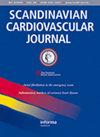Urinary orosomucoid is associated with diastolic dysfunction and carotid arteriopathy in the general population. Cross-sectional data from the Tromsø study
IF 1.2
4区 医学
Q3 CARDIAC & CARDIOVASCULAR SYSTEMS
引用次数: 1
Abstract
Abstract Objectives. Urinary albumin excretion is a risk marker for cardiovascular disease (CVD). Studies suggest that urinary orosomucoid may be a more sensitive marker of general endothelial dysfunction than albuminuria. The aim of this population-based cross-sectional study was to examine the associations between urinary orosomucoid to creatinine ratio (UOCR), urinary albumin to creatinine ratio (UACR) and subclinical CVD. Design. From the Tromsø Study (2007/2008), we included all men and women who had measurements of urinary orosomucoid (n = 7181). Among these, 6963 were examined with ultrasound of the right carotid artery and 2245 with echocardiography. We assessed the associations between urinary markers and subclinical CVD measured as intima media thickness of the carotid artery, presence and area of carotid plaque and diastolic dysfunction (DD). UOCR and UACR were dichotomized as upper quartile versus the three lowest. Results. High UOCR, adjusted for UACR, age, cardiovascular risk factors and kidney function, was associated with presence of DD in men (OR: 3.18, 95% CI [1.27, 7.95], p = .013), and presence of plaque (OR: 1.20, 95% CI [1.01, 1.44], p = .038) and intima media thickness in women (OR: 1.34, 95% CI [1.09, 1.65], p = .005). Analyses showed no significant interaction between sex and UOCR for any endpoints. UACR was not significantly associated with DD, but the associations with intima media thickness and plaque were of magnitudes comparable to those observed for UOCR. Conclusions. UOCR was positively associated with subclinical CVD. We need prospective studies to confirm whether UOCR is a clinically useful biomarker and to study possible sex differences.在一般人群中,尿类骨质疏松与舒张功能障碍和颈动脉病变有关。Tromsø研究的横截面数据
抽象目标。尿白蛋白排泄是心血管疾病(CVD)的危险标志。研究表明,尿类骨质疏松症可能是比蛋白尿更敏感的一般内皮功能障碍的标志物。这项以人群为基础的横断面研究的目的是检查尿类骨质疏松与肌酸酐比率(UOCR)、尿白蛋白与肌酸酐比值(UACR)与亚临床CVD之间的关系。设计在Tromsø研究(2007/2008)中,我们纳入了所有测量过尿类骨质疏松症的男性和女性(n = 7181)。其中6963例行右颈动脉超声检查,2245例行超声心动图检查。我们评估了尿标志物与亚临床CVD之间的相关性,如颈动脉内膜-中膜厚度、颈动脉斑块的存在和面积以及舒张功能障碍(DD)。UOCR和UACR被分为上四分位数和三个最低四分位数。后果经UACR、年龄、心血管危险因素和肾功能调整后,高UOCR与男性DD的存在相关(OR:3.18,95%CI[1.27,7.95],p = .013),以及斑块的存在(OR:1.20,95%CI[1.01,1.44],p = .038)和女性内膜-中膜厚度(OR:1.34,95%CI[1.09,1.65],p = .005)。分析显示,在任何终点,性别和UOCR之间没有显著的相互作用。UACR与DD无显著相关性,但与内膜-中膜厚度和斑块的相关性与UOCR的相关性相当。结论。UOCR与亚临床CVD呈正相关。我们需要前瞻性研究来确认UOCR是否是一种临床有用的生物标志物,并研究可能的性别差异。
本文章由计算机程序翻译,如有差异,请以英文原文为准。
求助全文
约1分钟内获得全文
求助全文
来源期刊

Scandinavian Cardiovascular Journal
医学-心血管系统
CiteScore
3.40
自引率
0.00%
发文量
56
审稿时长
6-12 weeks
期刊介绍:
The principal aim of Scandinavian Cardiovascular Journal is to promote cardiovascular research that crosses the borders between disciplines. The journal is a forum for the entire field of cardiovascular research, basic and clinical including:
• Cardiology - Interventional and non-invasive
• Cardiovascular epidemiology
• Cardiovascular anaesthesia and intensive care
• Cardiovascular surgery
• Cardiovascular radiology
• Clinical physiology
• Transplantation of thoracic organs
 求助内容:
求助内容: 应助结果提醒方式:
应助结果提醒方式:


